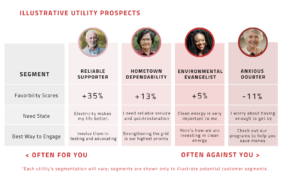Utilities are increasingly understanding that their customer base is not a homogenous group,
with a uniform point-of-view of how electricity relates to their lives. Instead, we are seeing
more energy providers deploy segmentation strategies that can dramatically improve customer
satisfaction.
For any company, the holy grail of marketing communications is message personalization and
customization, whereby your customers receive messages about issues, products, and services
that they care about, framed in their individual worldviews. In this world, a customer named
Mark would receive a message customized uniquely to Mark, same with Mary, and every other
customer. Sophisticated retailers have moved beyond segmentation and are showing successes
with pure customization.
In a recent position paper, McKinsey said, “For some time now, companies have been trying to
address customer needs through personalization, using data and analytics to craft more
relevant consumer experiences. The goal is to present consumers with compelling offers and
tailored, resonant messages at the right time. Today’s customers want more of this…71 percent
of consumers expected companies to deliver personalized interactions, and 76 percent got
frustrated when it didn’t happen. When companies get it right, however, they can create
significant value.”
While pure customization may be a few years away for utilities, we are seeing more and more
energy providers find success with segmentation strategies, where messaging varies depending
on groups of customers. Said another way, the message (and the best way to engage) a group
of reliable supporters who generally are pleased with their utility might vary significantly from
the messages sent to customers who have high concerns about climate change.

Segmentation often relies on demographics and geographics (factual data), psychographics
(attitudinal data), and personality (behavioral data) through thousands of data points to
understand which messages most appeal to different audiences. Done right, we see utilities
increasing favorability scores across several audience segments. And as we know, better
customer communication drives higher customer satisfaction, which drives better regulatory
outcomes.
If, as Peter Drucker said, the aim of marketing is to know and understand customers so well
that the product or service fits them and sells itself, then a well-built segmentation strategy can
serve as an effective way for utility communicators to build tighter relationships with their
customers.


